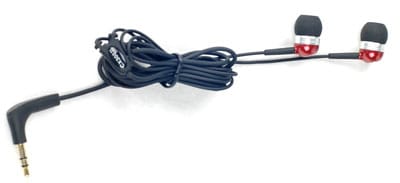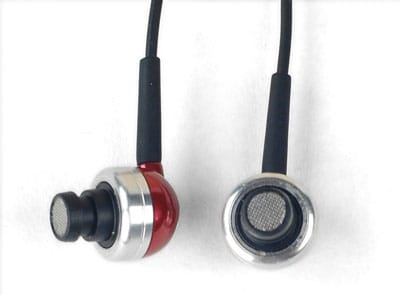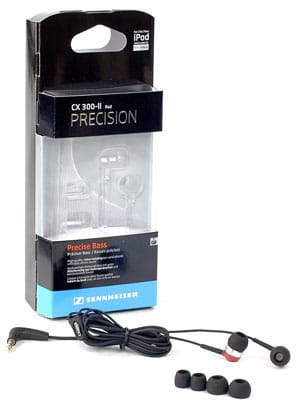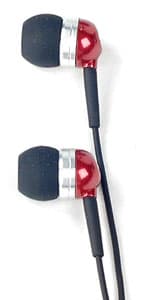Tour & Design
**
Tour**
The Sennheiser CX 300-IIs are an average-looking set of in-ears: buds on one end, plug on the other, not much in-between. The only twist on the formula is that the cord is asymmetrical, meaning the length of cord running from the neck split to the left ear bud is far shorter than the length running to the right. This is so you can sling the right side around the back of your neck.
[

](https://www.reviewed.com/headphones/images/upload/Image/Reviews/Sennheiser/CX_300-II/full-800.jpg)
The CX 300-IIs are an average set of in-ears with an above cord guard at the plug.
These should fair well when connected to media players in bags and pockets
(click pic for larger image).
The buds themselves are half metallic silver, half crimson ('gunmetal rouge' to V-MODA users). They have a good cord guard, which means the internal wires won't sever against the buds should you recklessly shove the headphones into your pocket for a while. The nozzles are fairly thick and grip sleeves tightly. The top of the nozzle has a wire mesh covering, to separate the headphones' innards from that pigsty you call an ear. Dont' fret: everyone else's ears are just as gross, hence the protective screen.
[

](https://www.reviewed.com/headphones/images/upload/Image/Reviews/Sennheiser/CX_300-II/nozzles-800.jpg)
The CX 300-IIs don't have any cleaning tools, so be careful you don't
grind any grime into the mesh: once it's inside, it's not coming out.
Both cables converge in a small bit of hard rubber. It seems to be very durable; we wouldn't worry about this thing tearing.
Your cable will snap before this thing even begins to tear.
This is a very sturdy neck split.
After the neck split, the cord ends in a standard 1/8-inch plug. It has a fairly robust cord guard, making it ideal for use with a pocket device.

Finally, check out the headphones on HATS, our testing buddy. While HATS might not be mistaken for your long-lost twin, you can't doubt there's some indescribable, somewhat uncanny resemblance. Hopefully it's a close enough likeness for you to get an idea of what your own head might look like with the CX 300-IIs in it.
The Sennheiser CX 300-IIs would be utterly unremarkable if it weren't for their red coloration.
In The Box
There isn't a lot in the CX 300-IIs' box. You'll get the headphones themselves and three pairs of sleeves total. There aren't any adapters, in-line accessories, or hidden secrets within the packaging.

The CX 300-IIs are of average durability. There really isn't anything specific about them they could break easily, but they have a thin cord that lacks a durable casing. There's also no way to fix or replace anything should it break down.

In-ear headphones aren't exactly a sprawling canvas of endless aesthetic opportunity. They're tiny and their design will often go unnoticed. This is the case with the CX 300-IIs: they have solidly average aesthetic appeal. They certainly aren't ugly by any stretch, but there also isn't anything about them that's eye-catching. We do like the splash of color, however, which is why they got ever-so-slightly above a solid 5.00.
Sound Quality
**
About our testing:**
For more information on our tests, read this article.
What we found:
The CX 300-IIs had a good frequency response – it wans't amazing, but it was solidly above average. They had good bass, which is something all good in-ears have to struggle for (bass requires moving a lot of air around, so the smaller the ear bud, the harder this is to do). The curve drops off a bit towards the mid-section, at which point the curve becomes slightly erratic, but manages to stay within the lines. After that the curve drops off a bit. Typically frequencies above 10,000 are used to add 'brilliance,' 'luster,' and a handful of other rather intangible qualities to sound. If you notice the loss at all, it'll likely manifest itself as softer vocal sibilance.
The only other issue here is that the bass might actually be slightly boomy for some. Many in-ears tend to over-correct the bass due to their aforementioned hardships at replicating it.
How the Sennheiser CX 300-II compares:
What is frequency response?
Frequency response refers to the way a set of headphones either stress or deemphasize any given frequency. Some headphones might add bass or put more of an emphasis on some of the middle frequencies to boost vocals. You can read more about this here.
How the test works:
What we do is play back a sweep of frequencies at a known file. The sound is output by the headphones and recorded by HATS's super awesome robot ears. Now we have the original file and that same file filtered through the headphones. Using these two parts, we can extrapolate what the headphones are doing to each individual frequency we tested. Again, you can find out more on our 'How We Test' page, here.
What we found:
The Sennheiser CX 300-IIs had very low distortion. Anything above an 8 or 9 here is excellent; anything close to or above a 10 will be redundant to the average consumer.
Really, you should have no problems with distortion on the CX 300-IIs.
How the Sennheiser CX 300-II compares:
**What is distortion?
**The short answer: distortion refers to any difference between the shape of the soundwave entering your headphones and what makes it to your ear. The long answer can be found on our 'How We Test' page, here.
How the test works:
What we do for this test is play back a known audio file, which is a frequency sweep from 100 to 10,000Hz. Like our frequency response test above, we record the playback as it comes out of the headphones, then compare it back to the original. Again, if you want more info, we have an in-depth explanation here.
What we found:
The CX 300-IIs had good tracking for the most part. It starts out a bit right-heavy – about 5 decibels louder in the right channel than in the left – but this difference could likely be a fit issue. Part of the problem with in-ears is that, if they aren't positioned perfectly, you end up losing quality or throwing off volume in some manner or another. Even with the offset, 5dB isn't particularly significant, especially with the low frequency involved. The curve flattens out towards the 100Hz mark, at which point it's relatively even through the remainder of the frequency spectrum. Towards the high end the graph gets a bit spikey, but that's slightly exaggerated: the testing equipment isn't 100% accurate for the highest and lowest end of the spectrum, but we leave them in the graph because they're good indicators of a trend. In this case, expect the left channel to get negligibly louder for higher frequencies.
How the Sennheiser CX 300-II compares:
**What is tracking?
**Tracking refers to the relative volumes of each individual headphone. If the right one is playing louder than the left for a handful of frequencies, then the left one gets louder, the headphones have poor tracking. Of course, there is no such thing as perfect tracking. For more on the subject, read this article.
How the test works:
This test is very similar to our frequency response test, only more focused. We play back our known audio file (a frequency sweep from 100-10,000Hz). Again, all we're looking for are points where one channel, be it left or right, is playing back at a higher volume. In the graph, when the blue line rises, it means the left channel is playing louder; when the line dips down, the right channel is louder. If you require more information on the subject, allow us to direct you to our 'How We Test' page.
Isolation
**Maximum Usable Volume** (10.00)
What we found:
The CX 300-II was capable of 122.14dB before distortion got out of hand. As a result, it gets our max score for the section, a 10.00. We have a cap on this score, because any more than 120dB is bad news for your hearing, and we care about you and your hearing.
**What is maximum usable volume?
**This term refers to the loudest volume you can get out of the headphones without going above 3% distortion. More than 3% distortion will result is bad audio quality, which no one wants. For more on this, go here.
How the test works:
This test is basically a series of distortion tests done at increasingly high decibel levels. Distortion increases as volume increases, so by incrementing the decibel output, we also ramp up distortion. Once again, if you want to know a bit more about this, head over to our 'How We Test' page.
What we found:
Compared to the average, non-active-noise-cancelling pair of on/over-ears, the CX 300-II has good isolation. Compared to other in-ears, however, the CX 300-II is solidly average. Like most other in-ears, the CX 300-IIs have some issues blocking out bass. Also like most other in-ear headphones, they block out a lot of middle-ranged tones.
Typically, in-ear headphones can isloate better than active noise-cancelling headphones, in terms of total sound blocked out. In this case, however, a mid-range active-canceller would out-cancel the CX 300-II consistently.
How the Sennheiser CX 300-II compares:
**What is maximum usable volume?
**This term refers to the loudest volume you can get out of the headphones without going above 3% distortion. More than 3% distortion will result is bad audio quality, which no one wants. For more on this, go here.
How the test works:
This test is basically a series of distortion tests done at increasingly high decibel levels. Distortion increases as volume increases, so by incrementing the decibel output, we also ramp up distortion. Once again, if you want to know a bit more about this, head over to our 'How We Test' page.
What we found:
Like most in-ears, the CX 300-IIs don't have an issue with leakage. This is partially because they create a good seal with the ear and partially because they're small and right next to your ear drum, so they don't have to be very loud. You won't have to worry about subjecting people on the bus to your techno remixes of Simon & Garfunkel's greatest hits.
What is leakage?
Leakage refers to any sound that escapes the seal between your ear and the ear bud or ear cup. If you've ever heard someone's music when they had headphones on, those headphones had horrible leakage control. Leakage is an issue if you're leaving your house, because no one wants to hear your breakbeat version of Scarborough Fair. In the privacy of your own home, however, leakage isn't likely to be an issue.
How the test works:
Our leakage test involves a microphone placed near the headphones, which HATS is wearing. We play some noise through the headphones and the microphone determines how much of it is audible over a short distance.
Comfort
The CX 300-IIs are pretty comfortable for in-ear headphones. After an hour of wear, we didn't have any comfort issues. Since the CX 300-IIs have an asymmetrical cable (the cord from the neck split to the left ear bud is significantly shorter than the cable connecting to the right), they're best worn around the back of the neck. If worn so the cable droops into a loop around your neck, the left ear bud will pull out ridiculously easily. When slung around the neck, however, the rubber will provide enough friction to keep that left bud from yanking out.
Even after 6 hours of constant wear, we didn't have a problem with the CX 300-IIs. Part of the upside of having thinner sleeves is less pressure being exerted on the insides of your ears. There were a few times where we forgot we were wearing them and there were a few times we were somewhat uncomfortably aware. The discomfort was mild at worst, however, and after a while would pass.
There aren't many options for customizing your CX 300-IIs. The headphones come with three sizes of soft plastic sleeves, which should help in finding a good fit. There aren't any other customizability options, not even an adjustable neck split.
Usability
It is exactly 4 feet and 9/16 of an inch to go from the plug's cord guard to the left ear bud's cord guard. This is average for a set of in-ears. It'll reach your front pocket with some slack, unless you are of a formiddible height.
In-ear headphones are portable by design. They're mostly cable, which is a thin gauge, with little plastic bits on one end and a small plug on the other. The CX 300-IIs are of average portability for in-ears. They don't come with a case or anything to help you store them when you're done listening, but they are small enough to just shove in a pocket.
In-ears typically don't give users great access to their inner workings. The CX 300-IIs are in this boat. The only thing you can do to clean or maintain the headphones is to remove the sleeves for cleaning. Some in-ears come with cleaning tools, but the CX 300-IIs trust that you can provide such things.
Battery Dependency
The CX 300-IIs do not require batteries to work. This is a marvelous thing because batteries are annoying and dumb.
Monster Turbines Comparison
Though the Turbines have a better aesthetic design, they do look a bit drab compared to the CX 300-IIs. The CX 300-IIs also have a more durable design. Compare the ear buds and plugs of the two headphones. The CX 300-II has better cord guards at the ear buds and a significantly better guard at the plug. Also, the plug is bent, which helps protect the internal wires better than a straight plug.
Both headphones have nearly the same frequency response.
The Turbines have slightly more distortion present, but it's a negligible ammount.
This isn't an obvious comparison, but the CX 300-IIs have a slightly better tracking. The graphs we use are normalized to enhance their readability, which sometimes eliminates a spike or two. Just trust us when we say the CX 300-IIs play on a slightly more even kiel. Practically speaking, the listener won't notice a difference between the two headphones.
The Turbines had slightly better isolation than the CX 300-Iis. Note the CX 300-IIs' graph shoots up a bit abruptly just before 1000Hz, while the Turbines creep up more gradually. Also, note the relative sizes of the big humps in each graph: the Turbines block out more sound in this area overall.
Both of these headphones are comfortable for in-ears.
The CX 300-IIs and Monster Turbines are comparable. They have about the same capabilities, although the CX 300-IIs are better in almost every quality. The CX 300-IIs also cost half what the Turbines cost. We're siding in favor of the Sennheisers.
Shure SE420 Comparison
The CX 300-IIs have a better aesthetic if only because they include a splash of color. The CX 300-II also has better cord guards at the ear buds. Both headphones manage the plug well.
The SE420s have a somewhat weaker bass, but have a much more even kiel to their response curve. The SE420s also have a weaker high end. The winner here will be decided by personal preference.**
**
The SE420s show a bit of distortion, but not much. We doubt the average consumer would notice. Both headphones did well on this test.
As with distortion, both headphones have good tracking. The SE420s have a much more even tracking, but again, there aren't huge leaps between the two performances.
The SE 420 is the clear winner on isolation. It is interesting to note that the CX 300-IIs block out the area around 1kHz much better than the SE420s. While this doesn't mean anything significant, we do get images of these two headphones teaming up against ambient noise like some crime fighting duo.
In lieu of posting a few HATS pictures, we'll actually use text for this comparason . We apologize for any inconvenience we caused when we totally forgot to take HATS photos of the Shure SE420s.
To sum it up in a word: similar. If we expanded that limit to three words to improve readability's: they are similar. We didn't have a strong preference as to which is better, so try them both on.
While the SE420s are great isolators, they fall short on just about every other area. Even though these shortcomings are small in scale, the SE420s cost over $100 more than the CX 300-IIs. If you value isolation, it's worth the extra investment, but otherwise we'd recommend the CX 300-IIs.
Sennheiser CX 95 Comparison
The CX 300-IIs, again, find themselves as the sportier, more festive option with slightly more durability thanks to their cord guards.
Since both of these headphones were made by Sennheiser and both have CX in their names, we aren't too shocked that they have nearly identical frequency responses.
We also weren't surprised to see both headphones with negligible distortion levels.
The CX 95s manage to eke out a slight advantage here with a much flatter tracking. Again, however, the differences aren't astounding.
Both headphones have very, very similar shapes to their isolation graphs.
We thought the CX 300-IIs were slightly more comfortable. The CX 95s' 'bent' design caused the cord to fall straight down, when it should naturally fall down and away. This led to the ear buds pulling out more easily.
The CX 95s and CX 300-IIs are very similar headphones. Both are pretty comfortable and have good audio quality. Neither isolate particularly well. The main difference between the two is price. The CX 95s are about $120 and the CX 300-IIs are about $75. This price difference isn't particularly large. If you prefer the CX 95s' sound, pick them up for the extra $45. If you're really on the fence about it, choose the CX 300-IIs and buy yourself something pretty with the difference.
Apple iPod in Ear Headphones Comparison
Honestly, the only time people notice your headphones is when they're a bright color or if they're white. In the latter case the observer probably wonders what kind of iPod you have. We think these two are about equal in terms of aesthetics. If you like or don't mind Apple, you probably prefer the black-bordered option on the right. If you hate apple, you'll probably default to the CX 300-IIs. It should be noted that the CX 300-IIs are more durable, regardless of your aesthetic inclinations.
Welp. It looks like the CX 300-IIs have a better bass response than the Apple headphones. Note the plunge towards the high end on the Apples as well. Sudden sharp lines like that are bad news and can lead to unnatural-sounding playback.
Again, this is a pretty clear victory for the CX 300-IIs. The bass distortion on the Apples is much higher than we typically see.
This one might be a bit less obvious. The worst thing to see on these graphs is scribbles: sharp ups or downs. Even if the curve favors the left side by 20dB, as long as the curve is a gradual slope, it'll be less jarring than a line zig-zagging between both channels with +/- 10dBit's preferrable to one that zig-zags from 10dB heavier on the left to 10dB heavier on the right.
There weren't significant differences in isolation.
The one comfort issue we ran into with the Apples was they kept falling out. This is annoying. Otherwise, both headphones were about as comfortable to wear.
This is one of those instances where an additional investment is worth the price. For an extra $45 or so, the CX 300-IIs will stay in your ears and provide significantly better audio quality.
Conclusion
Meet the tester
Mark Brezinski works on the Home Team, reviewing refrigerators, minifridges, dishwashers, washing machines, dryers, air conditioners, air purifiers, and fans.
Checking our work.
Our team is here to help you buy the best stuff and love what you own. Our writers, editors, and experts obsess over the products we cover to make sure you're confident and satisfied. Have a different opinion about something we recommend? Email us and we'll compare notes.
Shoot us an email